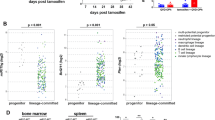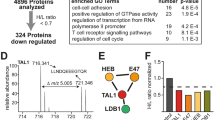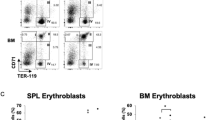Abstract
MicroRNAs (miRNAs or miRs) regulate diverse normal and abnormal cell functions. We have identified a regulatory pathway in normal megakaryopoiesis, involving the PLZF transcription factor, miR-146a and the SDF-1 receptor CXCR4. In leukaemic cell lines PLZF overexpression downmodulated miR-146a and upregulated CXCR4 protein, whereas PLZF knockdown induced the opposite effects. In vitro assays showed that PLZF interacts with and inhibits the miR-146a promoter, and that miR-146a targets CXCR4 mRNA, impeding its translation. In megakaryopoietic cultures of CD34+ progenitors, PLZF was upregulated, whereas miR-146a expression decreased and CXCR4 protein increased. MiR-146a overexpression and PLZF or CXCR4 silencing impaired megakaryocytic (Mk) proliferation, differentiation and maturation, as well as Mk colony formation. Mir-146a knockdown induced the opposite effects. Rescue experiments indicated that the effects of PLZF and miR-146a are mediated by miR-146a and CXCR4, respectively. Our data indicate that megakaryopoiesis is controlled by a cascade pathway, in which PLZF suppresses miR-146a transcription and thereby activates CXCR4 translation.
This is a preview of subscription content, access via your institution
Access options
Subscribe to this journal
Receive 12 print issues and online access
$209.00 per year
only $17.42 per issue
Buy this article
- Purchase on Springer Link
- Instant access to full article PDF
Prices may be subject to local taxes which are calculated during checkout








Similar content being viewed by others
References
Bartel, D. P. MicroRNAs: genomics, biogenesis, mechanism, and function. Cell 116, 281–297 (2004).
He, L. & Hannon, G. J. MicroRNAs: small RNAs with a big role in gene regulation. Nature Rev. Genet. 5, 522–531 (2004).
Ambros, V. The functions of animal microRNAs. Nature 431, 350–355 (2004).
Valencia-Sanchez, M. A., Liu, J., Hannon, G. J. & Parker, R. Control of translation and mRNA degradation by miRNAs and siRNAs. Genes Dev. 20, 515–524 (2006).
Zhao, Y., Samal, E. & Srivastava, D. Serum response factor regulates a muscle-specific microRNA that targets Hand2 during cardiogenesis. Nature 436, 214–220 (2005).
Naguibneva, I. et al. The microRNA miR-181 targets the homeobox protein Hox-A11 during mammalian myoblast differentiation. Nature Cell Biol. 8, 278–284 (2006).
Chen, J. F. et al. The role of microRNA-1 and microRNA-133 in skeletal muscle proliferation and differentiation. Nature Genet. 38, 228–233 (2006).
Esquela-Kerscher, A. & Slack, F. J. Oncomirs - microRNAs with a role in cancer. Nature Rev. Cancer 6, 259–269 (2006).
Chen, C. Z., Li, L., Lodish, H. F. & Bartel, D. P. MicroRNAs modulate hematopoietic lineage differentiation. Science 303, 83–86 (2004).
Fazi, F. et al. A minicircuitry comprised of microRNA-223 and transcription factors NFI-A and C/EBPα egulates human granulopoiesis. Cell 123, 819–831 (2005).
Felli, N. et al. MicroRNAs 221 and 222 inhibit normal erythropoiesis and erythroleukemic cell growth via kit receptor down-modulation. Proc. Natl Acad. Sci. USA 102, 18081–18086 (2005).
Fontana, L. et al. MicroRNAs 17–5p-20a-106a control monocytopoiesis through AML1 targeting and M-CSF receptor upregulation. Nature Cell Biol. 9, 775–787 (2007).
Georgantas, R. W. et al. CD34+ hematopoietic stem-progenitor cell microRNA expression and function: a circuit diagram of differentiation control. Proc. Natl Acad. Sci. USA 104, 2750–2755 (2007).
Kelly, K. F. & Daniel, J. M. POZ for effect-POZ-ZF transcription factors in cancer and development. Trends Cell Biol. 16, 578–587 (2006).
Ball, H., Melnick, A., Shaknovich, R., Kohanski, R. & Licht, JD. The promyelocytic leukemia zinc finger (PLZF) protein binds DNA in a high molecular weight complex associated with cdc2 kinase. Nucleic Acids Res. 27, 4106–4113 (1999).
Labbaye, C. et al. PLZF induces megakaryocytic development, activates Tpo receptor expression and interacts with GATA1 protein. Oncogene 21, 6669–6679 (2002).
Melnick, A. & Licht, J. D. Deconstructing a disease: RARα, its fusion partners, and their roles in the pathogenesis of acute promyelocytic leukemia. Blood 93, 3167–3215 (1999).
Parrado, A. et al. Deregulated expression of promyelocytic leukemia zinc finger protein in B-cell chronic lymphocytic leukemias does not affect cyclin A expression. Hematol. J. 1, 15–27 (2000).
Felicetti, F. et al. A. Role of PLZF in melanoma progression. Oncogene 23, 4567–4576 (2004).
Peled, A. et al. Dependence of human stem cell engraftment and repopulation of NOD/SCID mice on CXCR4. Science 283, 845–848 (1999).
Gazitt, Y. Homing and mobilization of hematopoietic stem cells and hematopoietic cancer cells are mirror image processes, utilizing similar signaling pathways and occurring concurrently: circulating cancer cells constitute an ideal target for concurrent treatment with chemotherapy and antilineage-specific antibodies. Leukemia 18, 1–10 (2004).
Lapidot, T., Dar, A. & Kollet, O. How do stem cells find their way home? Blood 106, 1901–1910 (2005).
Ratajczak, M. Z. et al. The pleiotropic effects of the SDF-1-CXCR4 axis in organogenesis, regeneration and tumorigenesis. Leukemia 20, 1915–1924 (2006).
Kucia, M. et al. Trafficking of normal stem cells and metastasis of cancer stem cells involve similar mechanisms:pivotal role of the SDF-1-CXCR4 axis. Stem Cells 23, 879–894 (2005).
Burger, J. A. & Kipps, T. J. CXCR4: a key receptor in the crosstalk between tumor cells and their microenvironment. Blood 107, 1761–1767 (2006).
Cottler-Fox, M. H. et al. Stem cell mobilization. Hematology 2003, 419–437 (2003).
Ruiz de Almodovar, C., Luttun, A. & Carmeliet, P. An SDF-1 trap for myeloid cells stimulates angiogenesis. Cell 124, 18–21 (2006).
Kim, H. K., Sierra, MD., Kimmel Williams, C., Gulino, AV. & Tosato, G. G-CSF downregulation of CXCR4 expression identified as a mechanism for mobilization of myeloid cells. Blood 108, 812–820 (2006).
Dar, A. et al. Chemokine receptor CXCR4-dependent internalization and resecretion of functional chemokine SDF-1 by bone marrow endothelial and stromal cells. Nature Immunol. l6, 1038–1046 (2005).
Avecilla, ST. et al. Chemokine-mediated interaction of hematopoietic progenitors with the bone marrow vascular niche is required for thrombopoiesis. Nature Med. 10, 64–71 (2004).
Pang, L., Weiss, M. J. & Poncz, M. Megakaryocyte biology and related disorders. J. Clin. Invest. 115, 3332–3338 (2005).
Quaranta, M. T. et al. PLZF-mediated control on VLA-4 expression in normal and leukemic myeloid cells. Oncogene 25, 399–408 (2006).
Testa, U. et al. Terminal megakaryocytic differentiation of TF-1 cells is induced by phorbol esters and thrombopoietin and is blocked by expression of PML/RARα fusion protein. Leukemia 12, 563–570 (1998).
Tabilio, A. et al. Myeloid and megakaryocytic properties of K-562 cell lines. Cancer Res. 10, 4569–4574 (1983).
Guerriero, R. et al. Stromal cell-derived factor 1α increases polyploidization of megakaryocytes generated by human hematopoietic progenitor cells. Blood 97, 2587–2595 (2001).
Ivins, S. et al. Regulation of Hoxb2 by APL-associated PLZF protein. Oncogene 22, 3685–3697 (2003).
Gabbianelli, M. et al. “Pure” human hematopoietic progenitors: permissive action of basic fibroblast growth factor. Science 249, 1561–1564 (1990).
Chen, C. Z. MicroRNAs as oncogenes and tumor suppressors. N. Engl. J. Med. 353, 1768–1771 (2005).
Calin, G. A. et al. Frequent deletions and down-regulation of micro- RNA genes miR15 and miR16 at 13q14 in chronic lymphocytic leukemia. Proc. Natl Acad. Sci. USA 99, 15524–15529 (2002).
He, H. et al. The role of microRNA genes in papillary thyroid carcinoma. Proc. Natl Acad. Sci. USA. 102, 19075–19080 (2005).
Taganov, K. D., Boldin, M. P., Chang, K. J. & Baltimore, D. NF-κB-dependent induction of microRNA miR-146, an inhibitor targeted to signaling proteins of innate immune responses. Proc. Natl Acad. Sci. USA 103, 12481–12486 (2006).
Wang, J. F., Liu, Z. Y. & Groopman, J. E. The α-chemokine receptor CXCR4 is expressed on the megakaryocytic lineage from progenitor to platelets and modulates migration and adhesion. Blood 92, 756–764 (1998).
Garzon, R., et al. MicroRNA fingerprints during human megakaryocytopoiesis. Proc. Natl Acad. Sci. USA. 103, 5078–5083 (2006).
Wang, J., Loberg, R. & Taichman, R. S. The pivotal role of CXCL12 (SDF-1)/CXCR4 axis in bone metastasis. Cancer Metastasis Rev. 25, 573–587 (2006).
Littman, D. R. Chemokine receptors: keys to AIDS pathogenesis? Cell 93, 677–680 (1998).
Nanki, T. et al. Stromal cell-derived factor-1-CXC chemokine receptor 4 interactions play a central role in CD4+ T cell accumulation in rheumatoid arthritis synovium. J. Immunol. 165, 6590–6598 (2000).
Tamamura, H. & Fujii, N. The therapeutic potential of CXCR4 antagonists in the treatment of HIV infection, cancer metastasis and rheumatoid arthritis. Expert Opin. Ther. Targets 9, 1267–1282 (2005).
Carè, A. et al. MicroRNA-133 controls cardiac hypertrophy. Nature Med. 13, 613–618 (2007).
Krutzfeldt, J. et al. Silencing of microRNAs in vivo with 'antagomirs'. Nature 438, 685–689 (2005).
Acknowledgements
We are grateful to M. Fontana, V. Michetti and M. Blasi for editorial assistance. We thank G. Loreto for graphics and A. M. Cerio for technical support. This work was supported by Italy National Grants (Progetto Oncotecnologico, Programma Nazionale Italia-USA in Oncologia) to C.P., institutional grants from the Italian Ministry of Health (Alleanza Contro il Cancro, Programma Straordinario di Ricerca Oncologica 2006) to U.T. and C.L. and Associazione Italiana per la Ricerca sul Cancro (AIRC) to R.F. and F.G.
Author information
Authors and Affiliations
Contributions
C.L., I.S. M.T.Q., E.P., L.P., E.P., M.B., E.R.N., R.F. and U.T. performed experiments; E.B. provided cord-blood samples; F.G. revised the paper. C.L. and C.P. planned and designed the experiments and wrote the paper.
Corresponding authors
Ethics declarations
Competing interests
The authors declare no competing financial interests.
Supplementary information
Supplementary Information
Supplementary Figures S1, S2, S3, S4, S5 and Supplementary Methods (PDF 800 kb)
Rights and permissions
About this article
Cite this article
Labbaye, C., Spinello, I., Quaranta, M. et al. A three-step pathway comprising PLZF/miR-146a/CXCR4 controls megakaryopoiesis. Nat Cell Biol 10, 788–801 (2008). https://doi.org/10.1038/ncb1741
Received:
Accepted:
Published:
Issue Date:
DOI: https://doi.org/10.1038/ncb1741
This article is cited by
-
Insight into microRNAs’ involvement in hematopoiesis: current standing point of findings
Stem Cell Research & Therapy (2023)
-
Atorvastatin Pretreatment Ameliorates Mesenchymal Stem Cell Migration through miR-146a/CXCR4 Signaling
Tissue Engineering and Regenerative Medicine (2021)
-
Identifying microRNA determinants of human myelopoiesis
Scientific Reports (2018)
-
miR-210 expression in PBMCs from patients with systemic lupus erythematosus and rheumatoid arthritis
Irish Journal of Medical Science (1971 -) (2018)
-
Is There a Relationship Between CXCR4 Gene Expression and Prognosis of Immune Thrombocytopenia in Children?
Indian Journal of Hematology and Blood Transfusion (2017)



